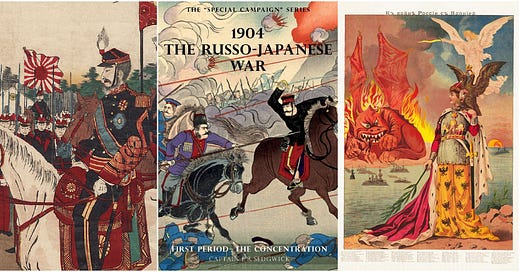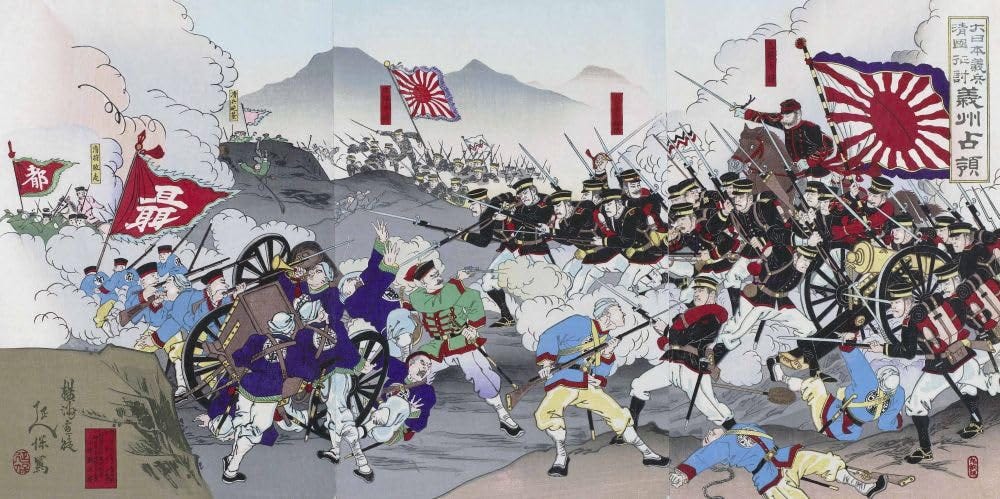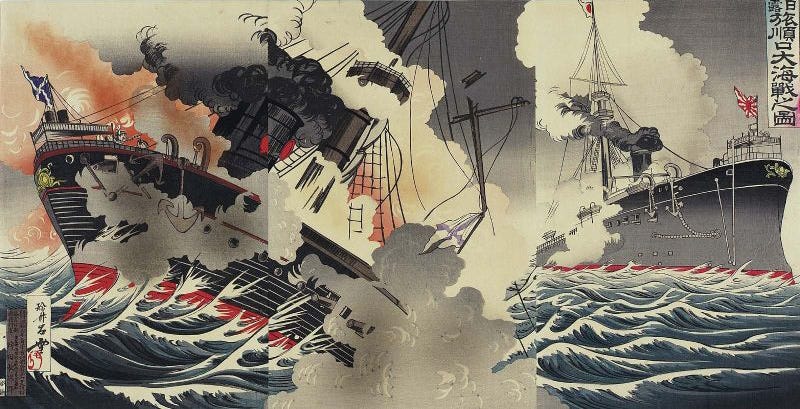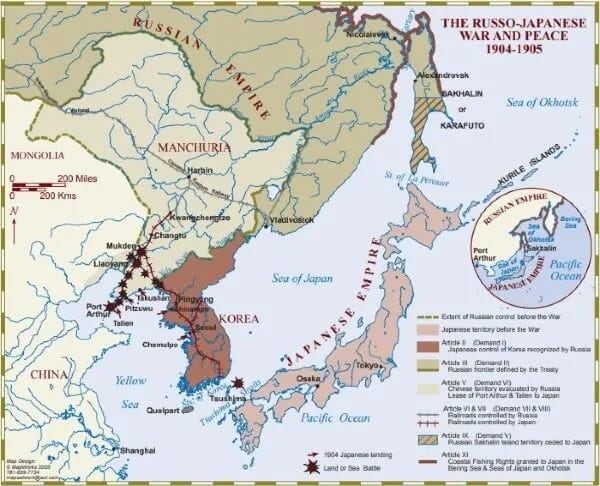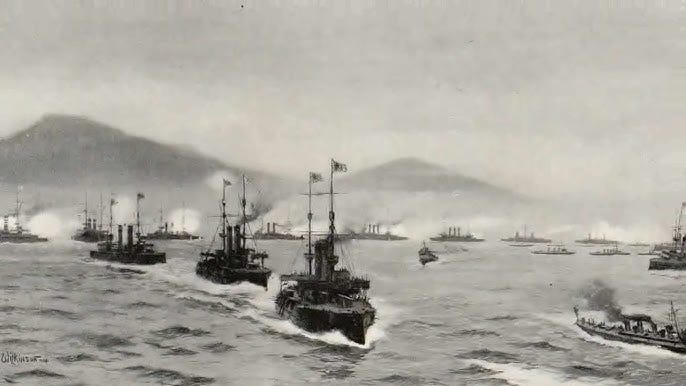Japan was an insular nation for centuries until contact with the Portuguese explorers and traders. Japan insisted on limited access to the outside world even after this contact. They set a singular access point for their partner to go through. This singular partnership phase lasted three hundred years until 1853 when the United States demanded access to two ports, and other nations followed demanding access. Japan acquiesced because other nations were more powerful and forced their hand.
The opening of Japan to the contemporary economic and military systems was a shock to the Japanese leadership. They embarked on a new path towards acting on the world stage. Within 50 years, their progress led to the Russo-Japanese War of 1904. The war changed perceptions in Europe and Asia and ushered in a new world order where Asian powers had to be considered. No longer could Asia be ignored as being backward and ineffectual.
Setting the Stage
Gunboat Diplomacy
In 1853, a US naval squadron entered Tokyo Bay and demanded access to two ports in Japan. This initiative was instigated by President Fillmore and was designed to establish a refueling port for American whaling interests. It also forced Japan to allowing foreigners into the country for trading interests.
Japan was reluctant to agree this, but the strength of the American warshipsforced their hand. This foreign dominance was a situation Japan did not want to repeat. Still, the country was forced to allow US access to Japanese markets in 1854. In 1858, Japan was forced to open trade deals with other Western powers at America’s insistence.
Foreign Access Led to the Meiji Restoration
In 1866, Japan’s traditional multipolar rule was overthrown, and the winning forces put Emperor Meiji back on the throne. The result was consolidated rule in Japan, and a centralized government was implemented. Internal warfare ended in 1872, when the Imperial forces completed the unification of the nation.
With a recent history of Japanese interests suffering at the whims of the colonial powers, the Meiji Restoration began the process of nation-building. Japan imported education techniques and adopted Western inventions and military tactics. The restoration produced newer military hardware, advances in science, and an appreciation of native arts. The Japanese adopted naval tactics from the British Navy. They embarked on a path to rapidly grow their navy. Some of the new craft were built in Japan while other maritime warfare boats were built in Britain or France.
To implement the army’s modernization, Japan first turned to France. However, the Franco-Japanese relationship was unsuccessful. After seeing Prussia defeat continental forces, Japan turned to Prussia/Germany to train, equip, and organize the Japanese army. Prussian-style command structures, tactics, and even uniforms were introduced.
These capabilities were first tested in the first Sino-Japanese War in 1894.
Note: There is an excellent in-depth overview of the Meiji Period at The History Desk.
Sino-Japanese 1894 War
The first Sino-Japanese War started in July of 1984. Japan took its newly upgraded and Westernized forces into war against the Chinese Qing dynasty, which had also attempted to upgrade its military capabilities similarly.
The proximate cause of the war was the political situation in Korea. The Chinese and Japanese empires competed for dominance of Korea for decades when war was declared in 1894. For purposes of this post, no summary of the war is necessary, only the summary of the outcome. Japan decisively defeated the Chinese forces. Japan’s intense efforts at modernization were successful, and Japan was acknowledged as the preeminent power in Asia.
However, Russian political machinations thwarted the expected results in Japan. Russia expanded its holding in China and managed the Manchurian territories around Port Arthur (now Lushun). Other powers moved into China, but the Russians directly challenged Japanese interests. Russia moved into Korea to protect it as a vassal state. The Russians also moved into Manchuria – the large area between Russia and China. Japanese attempts to set up spheres of influence, Japan over Korea and Russia over Manchuria, were stalled by the Russian Empire. The Russians believed that they were strong enough to reject any compromise. They also thought Japan would not go to war with a European power. They were wrong.
The Russo – Japanese War
The War between the Empires of Russia and Japan culminated from disagreements after the Sino-Japanese War. Russia occupied the city of Port Douglas (Lushun) to create a permanent warm-water port on the Pacific. Russia ultimately proposed a buffer line at the 39th parallel, which would have left Russia dominant in Northern Korea, Manchuria, and Northwest China.
This proposal was seen as a direct assault against the Japanese. Japan wanted to expand its Empire into Korea and parts of Manchuria. Japan and Russia hardened their positions, and diplomacy failed.
In February of 1904, the Japanese Navy staged a surprise attack against the Russian Fleet in Port Arthur. The fleet was destroyed, and Russia declared war on Japan. Japan decisively beat Russian forces in battles over the next year, but the Tsar was unwilling to concede a humiliating loss. Russia refused Japanese efforts to take the issues to the Court of Arbitration or support an armistice. Both would have left Russia in a better position than a loss to Japan, but the Russian Tsar Nicholas could not imagine Japan beating a world power.
Russia Responds
Russia bet on a strategy of prolonging the war while Russian fleets from the Black and Baltic Seas steamed toward Japan. The plan was to bring the fleet to the Russian port of Vladivostok, relieve Russian soldiers in Manchuria, and destroy the Japanese Fleet. In 1905, the Russian fleet met the Japanese fleet in the Battle of Tsushima – the strait between Korea and Japan. It was a complete defeat at the hands of the Japanese. Ultimately, the Russian fleet, including all seven of Russia’s battleships, was destroyed or captured.
This battle finally moved Russia and Japan towards negotiations led by US President Teddy Roosevelt.
Russia acceded because of both its defeat by Japan and the internal threats against the Tsar in European Russia, which needed his military and attention.
Japan acceded to the talks from a position of military strength. Japan was granted effective control over Korea, which it annexed in 1910, and took over the Russian leasehold rights in China (Port Arthur and the surrounding area). Furthermore, Russia agreed to the demand for their soldiers to leave Manchuria. Japan agreed to these terms because the Japanese Empire had a growing debt crisis to continue the War.
Fallout from the War
The treaty was hailed as a success for peace in most of the world, and President Roosevelt received the Nobel Peace Prize for his work. But neither participant was satisfied with the treaty itself.
Japanese acceptance
The War was the first time an Asian power beat a European power. Japan’s prestige in Europe and the world rose, becoming a nearly equal contemporary of the European powers. For Europeans, the demands of keeping their holdings in the Far East were drastically more expensive if they faced Japan.
The terms of the peace treaty gave Japan more territory, prestige, and a more significant voice on the diplomatic stage. The entire world was impressed with the Japanese show of power.
Japanese / US antagonism
Japan looked at the final Treaty of Portsmouth in a very different way. The American-imposed treaty did not include granting Japan the Russian Far East territories or any indemnity payment from Russia. Japanese blamed the United States for these results. They viewed the peace terms as holding Japan hostage to American desire for Asian gains. After the treaty, three days of anti-American riots broke out in Japan, requiring the Japanese authorities to declare martial law in Tokyo.
After the war, Japan continued to grow its influence in Eastern Asia, consolidating its control of Formosa (Taiwan), Korea, and parts of China. Ultimately, the Japanese Empire invaded and annexed Manchuria in 1931. Japan was also admitted to the Great Power conferences in Europe. Its navy grew to be the second strongest in the world and dominated Asia.
Modernization of War
The Russo-Japanese War proved that an updated military could prevail over a much larger but less modern opponent. The smaller Japanese army forces were disciplined and better equipped during the Russo-Japanese War. They defeated the much larger Russian forces, who were poorly equipped and undisciplined. For humiliated Russia, the modernization of their forces was critical. The changes this war brought allowed Imperial Russia to hold off Germany in World War I for years.
The Japanese Navy proved even more powerful internationally. Japan became the first Asian nation to be able to project its power far from its territory.
Imperial Japan expanded militarily and geographically from the Russo-Japanese War in 1904 for nearly two decades until they attacked Pearl Harbor, bringing the United States into World War II.
The Russo-Japanese War changed the balance of power in the early 20th century. It introduced a multipolar world in which the nations of the Far East had to be considered and consulted.

